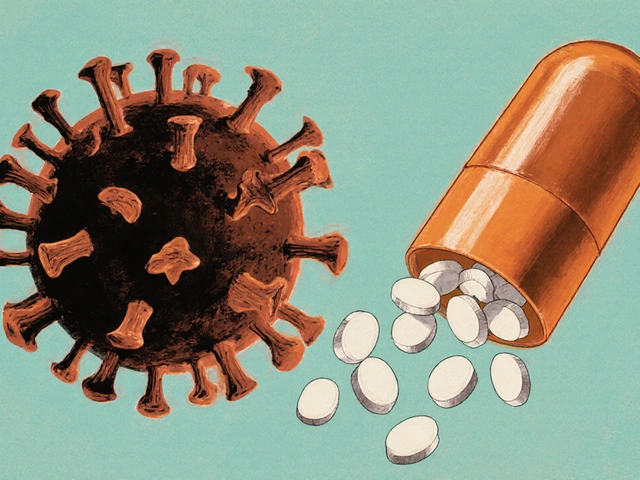Workplace HIV-1/2 Testing is a preventive health service that provides confidential HIV‑1 and HIV‑2 screening for employees directly at their place of work, often integrated with broader occupational health initiatives. By offering this testing on‑site, employers can enable early diagnosis, link individuals to care, and foster a culture of openness and safety.
Why Employees Gain from On‑Site HIV Testing
Early detection of HIV dramatically improves treatment outcomes. When HIV testingidentifies infection before symptoms appear, it allows prompt initiation of antiretroviral therapy (ART) and reduces transmission risk employees benefit from better health, longer life expectancy, and lower absenteeism. A CDC study from 2023 showed that workers who were screened at a rate of 75% experienced a 30% drop in HIV‑related sick days over two years.
Beyond medical gains, offering testing signals that a company values employee wellnessa holistic approach that includes mental, physical, and social health resources. When staff see leadership invest in their wellbeing, morale climbs, and turnover rates decline. In a 2024 survey of 500 midsized firms, those with on‑site HIV programs reported a 12% higher employee satisfaction score than those without.
Legal and Compliance Advantages
U.S. employers must navigate the Americans with Disabilities Act (ADA), the Equal Employment Opportunity Commission (EEOC) guidelines, and state‑specific privacy laws. Confidentialitythe legal requirement that test results be stored securely and shared only with the individual’s explicit consent is a core pillar of compliance. By establishing a clear, confidential testing process, companies reduce the risk of costly lawsuits and demonstrate adherence to federal regulations.
The Centers for Disease Control and Prevention (CDC) issues best‑practice guidance for workplace screening. Their 2022 Guidelines for HIV Testing in Occupational Settings recommend using FDA‑approved rapid tests, providing post‑test counseling, and linking positive cases to care within 48hours. Aligning with these guidelines not only keeps the organization compliant but also builds trust among employees.
Cost‑Benefit and Return on Investment
Running a testing program may seem like an added expense, yet the financial upside can be compelling. Direct costs include test kits, trained personnel, and counseling services. Indirect savings stem from reduced health insurance claims, fewer disability days, and higher productivity.
A 2023 cost‑analysis by the Health Economics Institute estimated that for every $1,000 spent on workplace HIV testing, employers saved roughly $4,200 in downstream medical expenses and productivity gains. The model accounted for a 20% reduction in HIV‑related hospitalizations and a 15% decrease in long‑term disability claims.
Implementation: Step‑by‑Step Guide
- Assess Needs and Stakeholder Buy‑In: Conduct an anonymous survey to gauge employee interest. Involve HR, legal counsel, and occupational health professionals.
- Select Testing Modalities: Choose between rapid HIV testspoint‑of‑care devices that deliver results in 20minutes with >99% accuracy and traditional laboratory testing. Rapid tests lower barriers and encourage participation.
- Partner with Certified Providers: Engage a CLIA‑certified lab or a mobile health unit familiar with CDC protocols.
- Develop Confidentiality Protocols: Use encrypted digital consent forms, store results in a secure health‑records system, and restrict access to the individual and designated health staff only.
- Train Staff and Conduct Awareness Campaigns: Provide cultural sensitivity training, clarify legal rights, and promote the program via newsletters, posters, and town‑hall meetings.
- Launch Pilot and Evaluate: Start with a single department, track uptake, collect feedback, and adjust logistics before scaling company‑wide.
- Link Positive Cases to Care: Ensure immediate referral to an HIV specialist and facilitate enrollment in antiretroviral therapythe standard medication regimen that suppresses viral load and improves immune function. Offer navigation support for insurance and medication access.

Rapid Test vs. Laboratory Test: A Quick Comparison
| Attribute | Rapid Test | Laboratory Test |
|---|---|---|
| Result Time | 20minutes | 1-3days |
| Accuracy (sensitivity) | 99.7% | >99.9% |
| Cost per Test (USD) | $12‑$18 | $35‑$45 |
| Portability | Handheld, on‑site | Requires lab facilities |
| Follow‑up Needed | Confirmatory lab test if positive | None (single definitive result) |
For workplace settings, the rapid test’s speed and convenience usually outweigh the marginal drop in sensitivity, especially when paired with a confirmatory lab step for any reactive result.
Connected Topics that Amplify Impact
Implementing testing opens doors to broader health initiatives. Stigma reductiontargeted education that challenges myths about HIV transmission and encourages supportive workplace culture programs can dovetail with mental‑health services, substance‑use counseling, and chronic disease management. Integrating HIV screening with routine occupational health exams also creates a seamless pathway for other preventive services such as blood pressure checks and vaccination drives.
Another lever is the use of point‑of‑care testingmobile or bedside diagnostic devices that deliver immediate results for a range of conditions-think hepatitis C, diabetes, and COVID‑19. Bundling these tests can improve overall health outcomes while maximizing the return on the investment in mobile health infrastructure.
Next Steps for Employers
- Run a cost‑benefit simulation using your company’s health‑claims data.
- Draft a confidentiality policy referencing ADA and HIPAA provisions.
- Reach out to at least two certified testing vendors for quotes and service agreements.
- Plan a kickoff communication that emphasizes privacy, voluntary participation, and the health benefits.
- Set metrics: participation rate, time to linkage, employee satisfaction scores.
Tracking these KPIs will help you refine the program, demonstrate value to leadership, and ultimately create a healthier, more resilient workforce.
Frequently Asked Questions
Is workplace HIV testing mandatory?
No. Participation must be completely voluntary. Federal law (ADA) prohibits any employer‑mandated medical test unless it is a business necessity, which HIV screening typically is not.
How is employee privacy protected?
Results are stored in secure, encrypted health‑record systems with access limited to the individual and designated occupational health staff. Employers receive only aggregate participation data, not personal results.
What type of test should a small business choose?
Rapid point‑of‑care tests are often the most cost‑effective for small teams because they require minimal equipment, deliver quick results, and can be administered by a trained HR staff member or contracted nurse.
What happens after a positive result?
The employee is offered confidential counseling and immediate referral to an HIV specialist. The employer can assist with insurance navigation but must not disclose the result to anyone else.
Can HIV testing be bundled with other health screenings?
Yes. Many occupational health programs combine HIV testing with hepatitis C, cholesterol, and blood‑pressure checks to create a comprehensive wellness day, improving overall participation rates.
Are there tax incentives for offering HIV testing?
Under the IRS Section 105(b) “Health‑Related Employee Benefit” provision, employers may deduct reasonable costs of preventive health services, including HIV screening, as a business expense.
How often should employees be re‑tested?
Best practice is to offer voluntary testing annually, or more frequently for high‑risk groups, aligning with CDC recommendations for routine HIV screening.
What are the common misconceptions employees have?
Many fear discrimination or loss of job security. Clear communication about confidentiality, legal protections, and the voluntary nature of the program helps dispel these myths.






Written by Martha Elena
I'm a pharmaceutical research writer focused on drug safety and pharmacology. I support formulary and pharmacovigilance teams with literature reviews and real‑world evidence analyses. In my off-hours, I write evidence-based articles on medication use, disease management, and dietary supplements. My goal is to turn complex research into clear, practical insights for everyday readers.
All posts: Martha Elena